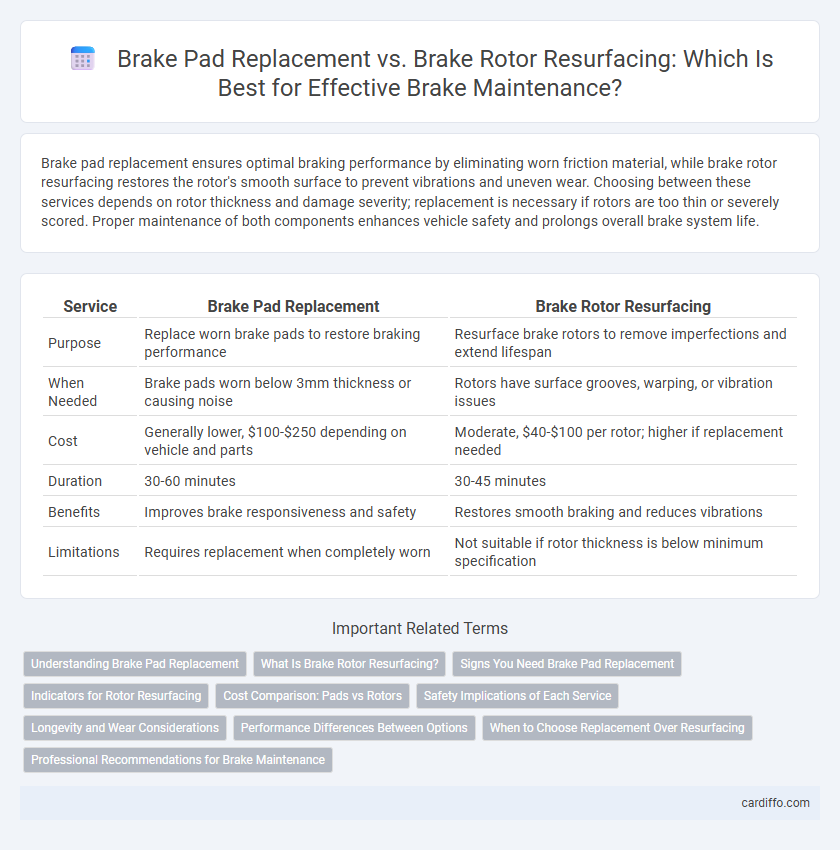Brake pad replacement ensures optimal braking performance by eliminating worn friction material, while brake rotor resurfacing restores the rotor's smooth surface to prevent vibrations and uneven wear. Choosing between these services depends on rotor thickness and damage severity; replacement is necessary if rotors are too thin or severely scored. Proper maintenance of both components enhances vehicle safety and prolongs overall brake system life.
Table of Comparison
| Service | Brake Pad Replacement | Brake Rotor Resurfacing |
|---|---|---|
| Purpose | Replace worn brake pads to restore braking performance | Resurface brake rotors to remove imperfections and extend lifespan |
| When Needed | Brake pads worn below 3mm thickness or causing noise | Rotors have surface grooves, warping, or vibration issues |
| Cost | Generally lower, $100-$250 depending on vehicle and parts | Moderate, $40-$100 per rotor; higher if replacement needed |
| Duration | 30-60 minutes | 30-45 minutes |
| Benefits | Improves brake responsiveness and safety | Restores smooth braking and reduces vibrations |
| Limitations | Requires replacement when completely worn | Not suitable if rotor thickness is below minimum specification |
Understanding Brake Pad Replacement
Brake pad replacement involves removing worn brake pads and installing new ones to restore proper braking performance and ensure safety. It is essential when brake pads reach a thickness below 3 millimeters, as thinning pads reduce braking efficiency and increase the risk of rotor damage. Regular brake pad replacement prevents costly repairs and maintains optimal vehicle stopping power under various driving conditions.
What Is Brake Rotor Resurfacing?
Brake rotor resurfacing involves machining the brake rotors to remove surface imperfections, restoring a smooth and even braking surface. This process extends the lifespan of the rotors by eliminating grooves, warping, and minor damage without needing immediate replacement. It is a cost-effective maintenance option when rotors remain above the minimum thickness specified by the manufacturer.
Signs You Need Brake Pad Replacement
Worn brake pads produce a distinct screeching or grinding noise when braking, signaling the need for immediate replacement to prevent damage to brake rotors. Reduced braking responsiveness or a spongy brake pedal often indicates significant pad wear compromising braking efficiency. Visible thinning or cracking of brake pads during inspection confirms that replacement is essential for maintaining safe vehicle operation.
Indicators for Rotor Resurfacing
Brake rotor resurfacing is typically indicated when the rotors exhibit minor surface irregularities such as light scoring, glazing, or uneven wear that do not compromise structural integrity. Visual signs include slight grooves or a smooth but uneven surface that can be restored by machining without reducing rotor thickness below manufacturer specifications. Rotors with cracks, deep grooves, or significant warping require replacement rather than resurfacing to ensure optimal braking performance and safety.
Cost Comparison: Pads vs Rotors
Brake pad replacement typically costs between $150 and $300 per axle, while brake rotor resurfacing ranges from $40 to $70 per rotor, making pad replacement more expensive upfront. However, rotor resurfacing extends the life of existing rotors and can be a cost-effective option if rotors are still within thickness specifications. Comparing long-term expenses, replacing pads alone often requires more frequent service intervals, whereas resurfaced rotors may reduce overall maintenance costs by delaying rotor replacement.
Safety Implications of Each Service
Brake pad replacement ensures optimal braking performance by restoring friction material essential for vehicle safety, preventing brake fade and increasing stopping power. Brake rotor resurfacing extends rotor lifespan by smoothing uneven surfaces but may reduce rotor thickness, potentially compromising heat dissipation and structural integrity. Prioritizing brake pad replacement over rotor resurfacing enhances overall safety by maintaining consistent brake function and minimizing risk of brake failure on the road.
Longevity and Wear Considerations
Brake pad replacement generally extends vehicle safety and performance by providing consistent friction material, while brake rotor resurfacing can temporarily restore rotor smoothness but may reduce rotor thickness, impacting durability. Over time, worn brake pads and resurfaced rotors can lead to increased heat buildup and uneven wear, accelerating brake system degradation. Prioritizing brake pad replacement ensures longer-lasting stopping power, whereas rotor resurfacing should be limited to marginal surface damage to maintain optimal brake component longevity.
Performance Differences Between Options
Brake pad replacement restores optimal stopping power by providing fresh friction material, enhancing braking responsiveness and safety, while brake rotor resurfacing smooths out uneven surfaces to prevent vibrations but may not fully restore rotor thickness or efficiency. New brake pads combined with resurfaced rotors generally deliver improved braking performance compared to pads paired with worn, thin rotors. Rotor resurfacing is best for minor surface issues, whereas replacing brake pads ensures maximum friction and consistent braking under high stress or performance driving conditions.
When to Choose Replacement Over Resurfacing
Brake pad replacement is necessary when pads are worn below the minimum thickness, causing reduced braking efficiency and increased stopping distances. Brake rotor resurfacing is suitable only if rotors have minor surface irregularities without cracks, warping, or thinning beyond manufacturer specifications. Always choose replacement over resurfacing if rotors show deep grooves, significant wear, or heat damage to ensure optimal brake performance and safety.
Professional Recommendations for Brake Maintenance
Professional recommendations for brake maintenance prioritize safety and performance, suggesting brake pad replacement when pads show wear beyond 3mm to ensure reliable stopping power. Brake rotor resurfacing is advised only if rotors maintain a minimum thickness as specified by the vehicle manufacturer, preventing compromised braking efficiency and potential rotor damage. Regular inspection by certified technicians helps determine the optimal balance between rotor resurfacing and pad replacement to extend brake system longevity.
Brake Pad Replacement vs Brake Rotor Resurfacing Infographic

 cardiffo.com
cardiffo.com